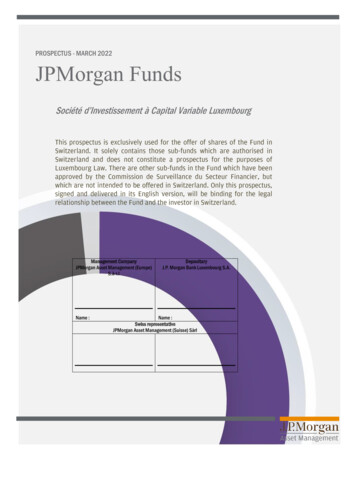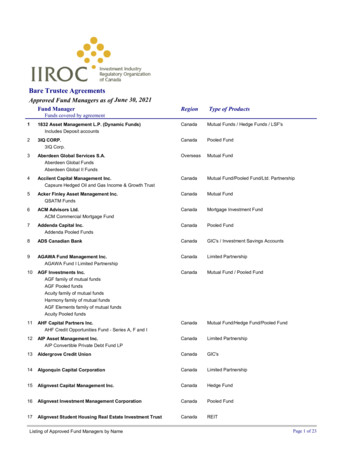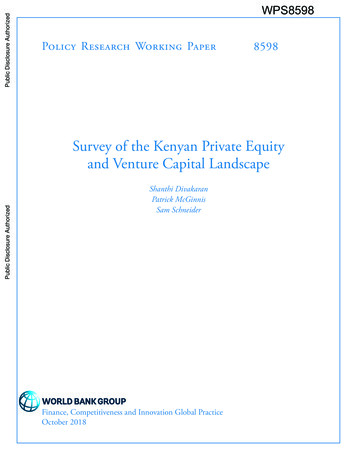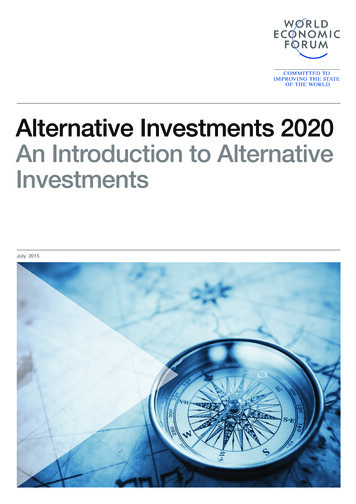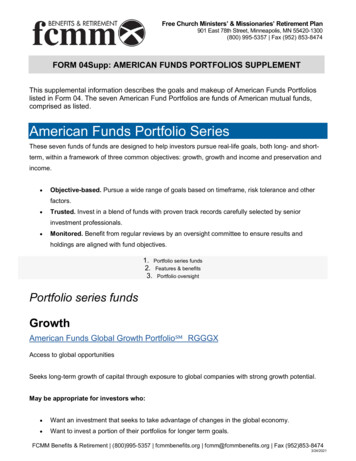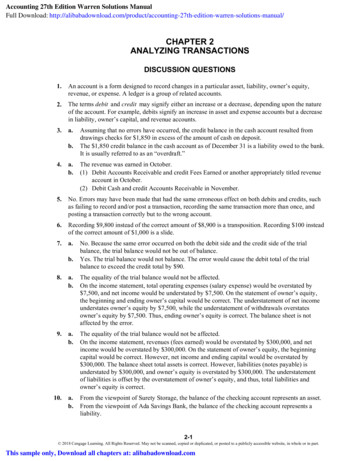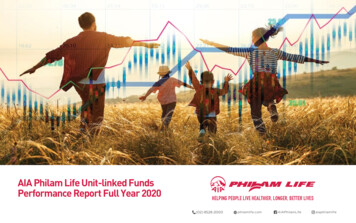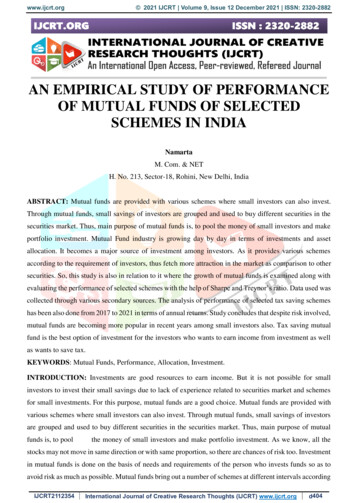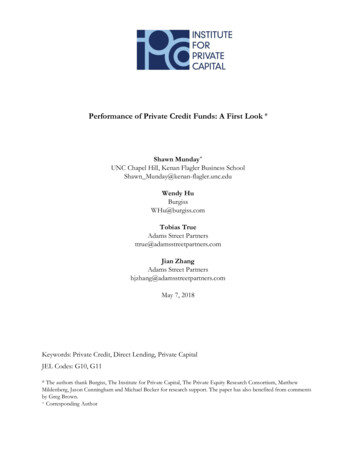
Transcription
Performance of Private Credit Funds: A First Look #Shawn Munday UNC Chapel Hill, Kenan Flagler Business SchoolShawn Munday@kenan-flagler.unc.eduWendy HuBurgissWHu@burgiss.comTobias TrueAdams Street Partnersttrue@adamsstreetpartners.comJian ZhangAdams Street Partnershjzhang@adamsstreetpartners.comMay 7, 2018Keywords: Private Credit, Direct Lending, Private CapitalJEL Codes: G10, G11The authors thank Burgiss, The Institute for Private Capital, The Private Equity Research Consortium, MatthewMildenberg, Jason Cunningham and Michael Becker for research support. The paper has also benefited from commentsby Greg Brown. Corresponding Author#
ABSTRACTAlthough private credit funds have rapidly grown into a standalone asset class over thelast decade, little is known about the aggregate performance of these funds. Toprovide a first look at absolute and relative performance, we utilize the Burgissdatabase of institutional quality private credit funds. Our analysis evaluates 476 privatecredit funds with nearly 480 billion in committed capital, including a subset of 155direct lending funds. We review the recent trends within private credit, provide anoverview of various strategies, describe returns since 2004 and compare private creditto several benchmark indices in order to develop a preliminary view of performanceand risk across various private credit strategies. Measures of absolute performancereveal IRRs that are positive for the top three quartiles across all sub-strategies.Measures of relative performance (PMEs) suggest that private credit funds haveperformed about as well, or better than, leveraged-loan, high-yield and BDC indexes.1. IntroductionPrivate credit funds rapidly grew in popularity before the financial crisis, but fundraisingactivity slowed significantly in 2009-2012. More recently private credit funds have collected capitalcommitments on par with the peak in 2008 and have cemented their position as a standalone assetclass. However, little is known about the characteristics, including performance, of the asset class.Limited disclosure requirements along with variations in strategy, differences in structure and lack oflong track records contribute to the problem. Several commercial data providers collect somedescriptive and performance data on these funds. However, each has a unique approach to doing so,incorporates different potential biases, and captures only a subset of the private credit fund universe.In this analysis, we utilize the Burgiss database of institutional-quality private credit funds to evaluateperformance of 476 private credit funds, including a subset of 155 direct lending funds. Utilizing thisdata set, we review the current trends within private credit, provide an overview of various strategies,describe returns since 2004 and compare private credit to several benchmark indices in order todevelop a preliminary view of performance and risk across various private credit strategies.Opportunities to invest in private credit have expanded dramatically over the last decade astraditional bank lending was constrained during the credit crisis and alternative sources of risk capitalstepped in to fill the void. In the wake of the financial crisis, many financial institutions faced theneed to de-lever, increased regulatory scrutiny and higher capital reserve requirements. In order tostrengthen their balance sheets and comply with the new regulatory regimes, traditional banks curtailedtheir corporate lending operations. As the banks retreated, asset managers developed a plethora of
private credit strategies to meet the growing capital needs of companies, particularly in the middlemarket. Similarly on the demand side, institutional investor appetite for private credit has grown.Faced with a historically low interest rate environment, institutional investors have increasedallocations to private credit under the auspices of attractive risk / reward characteristics, cash yieldsfrequently with an embedded inflationary hedge, expectations for low correlation with the rest of theirportfolio, and the assumptions of an imbedded liquidity premium relative to traditional fixed incomeinvestments.The increase of both supply and demand for private credit has resulted in substantial growthin assets under management (AUM). A recent analysis by Preqin reported that private credit AUMhas grown 16% annually since 2006, with most of that growth having been realized in the postfinancial crisis period. Panel A of Figure 1 shows that investments in private credit approached 600billion globally by the end of 2016.1 Likewise, a 2017 survey conducted by Pension & Investmentsindicated that U.S. institutional investors quadrupled allocations to private credit strategies in the yearssince the financial crisis (see Panel B of Figure 1). According to their survey, commitments to privatecredit grew every year since 2010 reaching 18.3 billion in 2016. In 2017, global private credit fundsclosed on 118.7 billion of new fund commitments, the most of any year on record.2 In fact, globalfundraising in private credit has grown more than 2.5 times the annual growth rate of private equitybuyout funds.32. The Structure of Private CreditPrivate credit includes a wide array of fund structures and investment strategies, so definingthe universe of private credit can be difficult. In the broadest sense, private credit investments aredebt-like instruments that have no readily tradeable market or publicly quoted price. Typically, privatedebt is provided by non-bank entities to fund middle-market companies, but can include funding forlarger companies as well. Private credit has many features similar to traditional credit instrumentsincluding variations in seniority, tenor, amortization, collateral provisions and floating or fixed interestrate coupons, among others. However, there is significant variation across private credit investmentfund structures and strategies.2017 Preqin Gobal Private Debt ReportSee Cox and Hanson (2017)3 Ibid122
Closed-end investment vehicles are often, but not exclusively, utilized to invest in privatecredit because of the limited liquidity in the underlying credits. Many private credit transactionsinvolve the bilateral negotiation of terms and conditions to meet the specific needs and objectives ofthe individual borrower and lender(s) without the need to conform or comply with traditionalregulatory or listing requirements. The bilateral origination of a loan between a single borrower andlender is often referred to as “direct lending”, but transactions originated between a borrower andnarrow group of lenders can be described as direct lending as well. Since there is often limited activetrading in the primary or secondary markets for many private credit instruments, lenders tend tostructure or purchase the loans with a view towards holding the exposure until maturity or arefinancing event. As a result, the instruments can include features uncommon to traditional loans,such as a structured equity component, high prepayment penalties, customized amortization scheduleor a role in oversight or management of the company. Private credit also includes both performingloans as well as debt in stressed or distressed companies.As a result of the significant variation in underlying strategies, terms, structure and liquidity,the risk and return expectations vary widely across private credit strategies. The landscape of privatecredit can include business development companies (BDCs), mezzanine funds, distressed funds,special situations funds, direct lending funds, and various other strategies like structured credit vehiclesor multi-credit strategy funds, among others. Definitions of private credit can also be expanded toinclude syndicated leveraged loan funds, venture debt and peer-to-peer lending platforms like LendingTree, Lending Club, and SoFi, but characteristics of these strategies begin to diverge from other privatecredit strategies.Structured, closed-end credit vehicles like CLOs that invest in syndicated leveraged loans areoften conflated with private credit. The leveraged loan market has many similar characteristics toprivate credit funds including structure, tenor, spread, less regulatory oversight, fewer reportingrequirements and trading in a smaller, less liquid market.The CLO structure has additionalcharacteristics that are similar to a private credit fund. However, there are substantial differences.The underlying assets, leveraged loans, are originated by banks on behalf of large corporate borrowers,rated by the credit rating agencies, syndicated to institutional investors and subsequently traded in thesecondary (over-the-counter) market. Also, syndicated leveraged loans generally have conformingcharacteristics such as seniority, terms and conditions and are almost exclusively originated by banksthat syndicate to institutional investors, which subsequently trade or hold the loans. As a result, there3
is less inherent price discovery, resulting in lower yields and higher volatility in the leveraged loanmarket compared to most private credit strategies. Similarly, while venture debt and peer-to-peerlending platforms are more analogous to private credit in terms of price uncertainty, liquidity and lackof a trading market, they compose a very small segment of the private credit landscape in terms oftotal AUM and come with idiosyncratic risks that make them less similar to more common privatecredit strategies. Consequently, syndicated leveraged loans funds like CLOs, venture debt and peerto-peer lending are excluded from this discussion.What follows is a brief description of the major strategies in private credit: Business Development Companies (BDCs): BDCs are closed-end investment vehiclesorganized under the Investment Company Act of 1940. BDCs generally invest in small andmid-sized companies through debt and equity securities as well as derivative securities. BDCsoperate under specific regulations designed to spur economic growth through investment insmall- and medium-sized businesses. For example, BDCs are required to make available“significant managerial assistance” to certain qualifying investments, leading to activeinvolvement by the BDC in the management and operations of many portfolio investments.The majority of BDCs elect to be treated as regulated investment companies (RIC) for taxpurposes, and as a result receive tax-exempt treatment on income, provided they distribute atleast 90% of their investment company taxable income. The additional regulatory oversightrequires detailed quarterly disclosure, including asset-level loan performance across theportfolio. BDCs can be private or publicly traded investment vehicles. Some BDCs haveorigination platforms allowing them to source and structure proprietary transactions whileothers either purchase assets in the secondary market or from other lenders. BDCs oftenutilize leverage at the fund level to enhance returns subject to certain statutory constraints.Investors allocate capital to BDCs with the expectations of attractive current income andcapital appreciation. Investors in publicly traded BDCs have access to all the requiredregulatory disclosure and the added benefit of daily liquidity. BDC managers typically targetgross returns in the high single digits to low double digits range. Senior Loan Funds: Senior Loan funds are closed-end vehicles that make senior loan (firstor second lien) or unitranche investments in small and mid-sized companies. Unitrancheinvestments are single-tranche financings that combine characteristics of senior and juniordebt and serve as the only debt in the company’s capital structure. Similar to BDCs, senior4
loan funds can have origination capabilities and often invest in private equity-backedcompanies. Senior loans utilize floating rate spreads composed of a risk premium thatincorporates the asset specific credit risk and a benchmark rate. Senior loan funds often utilizeleverage at the fund level to enhance returns. Senior loan managers typically target grossreturns in the high single digits to low double digits range. Mezzanine Funds: Mezzanine funds are closed-end vehicles that typically make junior capitalinvestments in small and mid-sized companies to fund acquisitions, growth, recapitalizationsor buyouts. Mezzanine capital is traditionally a hybrid between debt and equity taking theform of subordinated, unsecured debt or preferred stock. Most mezzanine funds haveorigination capabilities to source transactions, which are often private equity-backed leveragedbuyouts. Mezzanine capital typically includes a fixed-rate coupon commensurate with risksassociated with the subordinated position and often includes warrants or other equity-likefeatures to achieve return targets, subject to market conditions. This hybrid structure allowsa mezzanine investor to emphasize the capital preservation and current-pay features of a loanwhile also seeking additional upside through equity participation. Many mezzanine funds alsoutilize leverage at the fund level. Mezzanine fund managers typically target gross returns inthe mid- to upper-teens. Distressed Debt Funds: Distressed debt funds are closed-end or open-end vehicles thatinvest in debt securities of mid- to large-sized companies that are experiencing financialdistress. Investments are made either by purchasing at steep discounts in the open market orfrom existing creditors. Distressed debt managers can pursue a variety of strategies includingcontrol (loan-to-own), non-control and restructuring (or turnarounds), among others.Distress for control strategies invest in debt positions identified as the “fulcrum security”—the security that will typically receive the equity of the restructured company upon emergencefrom bankruptcy, and as a result control the go-forward operations of the company. Noncontrol strategies, more typical among hedge fund managers with open-end funds, targettemporary dislocations in a sector or business. These managers utilize trading strategies toderive attractive yields without pursuing control or holding their positions through arestructuring. Restructuring (or turnaround) strategies focus on acquiring assets at steepdiscounts that often have an attractive current yield. These strategies exert some operationalcontrol to dispose of or reposition specific assets and restructure the company’s capitalstructure to create value. Restructuring strategies are often executed over an extended period5
of time, sometimes several years, and as a result, closed-end fund structures are preferred sincemanagers can pursue their strategy without having to manage through redemption requests.While non-control strategies often utilized fund level leverage to enhance returns, it is lesscommon among distress for control and restructuring strategies. Distressed debt managerstypically target gross returns in the mid to upper-teens and above. Distress for control andrestructuring managers tend to target higher returns than non-control strategies due to theunderlying risk profile, extended hold period and reduced liquidity. Special Situation Funds are typically closed-end vehicles that target investment in mid- tolarge-sized companies undergoing pricing or liquidity dislocation caused by financial stress orevent-driven factors. These situations often involve borrowers with (a) stressed, complex, orunderappreciated assets, (b) cyclical, contrarian, or event-driven situations or (c) broadermarket dislocations. These funds can invest in both privately negotiated transactions and inthe secondary markets, seeking to earn strong risk-adjusted returns. Special situation fundsdiffer from distressed debt funds in that they have a much broader mandate of the type ofinvestments they pursue. Additionally, special situation funds can invest across the capitalstructure, including equity and structured equity. Special situation funds typically target grossreturns in the mid- to upper-teens. Other Funds (structured credit vehicles, opportunity funds, multi-credit strategy funds,specialty finance strategies, etc.): There are a host of other private credit vehicles that pursuea variety of alternative strategies including: structured credit vehicles like CLO’s (previouslydiscussed), CMBS, RMBS and ABS; tactical funds that invest opportunistically anywhere inthe capital structure to capture returns in idiosyncratic situations; sector specific strategies likeship leasing, aircraft leasing, royalty, art or intellectual property financing; and multi-strategyfunds that pursue some combination of other strategies as part of a focus on identify andcapturing returns through dislocation, illiquidity and mispricing opportunities.As previously mentioned, a distinction is increasingly made in the market for a subcategory offunds known as “direct lending” funds. The term “direct lending” is often used interchangeably withprivate credit, but should distinguish private credit funds that predominantly originate investmentopportunities bilaterally from private credit funds that predominantly source through a bank or someother intermediary.These direct lending funds cultivate proprietary relationships to sourcetransactions and make investments. These investments are generally senior obligations, but may6
include unitranche or junior capital. As a result, direct lending investment vehicles include both seniorloan and mezzanine funds, as well as BDCs and other funds that predominantly originate loans forinvestment through proprietary sourcing networks. Direct lending vehicles are often characterized asa stand-alone category within private credit because of the perceived benefit of bilateral negotiatedtransactions. Characteristics often attributed to direct lending funds are summarized in Figure 2.Perhaps because of the perceived benefit to investors attributable to proprietary originationversus sourcing through intermediaries, many private credit funds market themselves as direct lenders.Among the various private credit investment strategies, direct lending in particular has experiencedthe most substantial growth. A recent article in Pensions & Investments found that while institutionalinvestor commitments to private credit strategies continue to grow, direct lending funds have attracteda disproportionate amount of new commitments.4 According to a study by Pitchbook, 52.6 billionwas raised in direct lending funds in 2017, the highest ever. The growth rate of 39.4% annually since2009 far outpaced the broader 20.4% annual growth of global private credit over the same timeframe.5In addition to evaluating the performance of various private credit strategies, it is also helpful toevaluate direct lending separately, in order to determine if any of the perceived benefits ascribed to itby investors have manifested historically.3. DataA new private credit classification and dataset was made available by Burgiss in 2017. Weexamine a subset of the data that includes 476 private credit funds with vintage years between 2004and 2016. Summary statistics for our sample are provided in Table 1. Analogous to the Burgissbuyout and venture capital fund data utilized by Brown, Harris, Jenkinson, Kaplan, and Robinson(2015); Harris, Jenkinson, Kaplan and Stucke (2014); Harris, Jenkinson and Kaplan (2015), the privatecredit data are sourced from Burgiss. The Burgiss Manager Universe is a research-quality databasethat includes the complete transactional history for over 7,800 private capital funds with a totalcapitalization representing about 5.5 trillion in committed capital across the full spectrum of privatecapital strategies. It is representative of actual investor experience because the data are sourcedexclusively from limited partners, which avoids the natural biases introduced by sourcing data fromgeneral partners. The data include the date of cash flows and is further supplemented with fundprofiles. As a result, the Burgiss data include exact size and timing of cash flows as well as precise to45Pension & Investments Special Report: Private Credit, April 17, 20172017 Preqin Gobal Private Debt Report7
date fund valuations, which are typically reported by each fund on a quarterly basis. The fund dataare net of all fees, carried interest paid to the GP and fund-level leverage and thus represent net returnsto limited partners.As noted by Brown et al. (2015), the Burgiss dataset has a number of advantages, includingcash flow level data instead of self-reported IRRs and investment multiples, and size. The Burgissdata differs from many other datasets because of the level of data integrity and completeness thatcannot be achieved by voluntary reporting by GPs, or involuntary reporting via Freedom ofInformation Act (FOIA) or other public records requests. Given detailed and comprehensive cashflow data, it is possible to analyze fund and strategy performance more precisely. For example, we areable to calculate adjusted performance measures analogous to the Kaplan and Schoar (2005) publicmarket equivalents (PMEs) allowing the direct comparison of investments in particular private creditportfolios to an equivalently-timed investment in a benchmark index. The PME calculation discountsall cash flows (both fund contributions and distributions) using a benchmark return and provides aratio of discounted distributions to contributions. The implication is that a PME greater than 1.0indicates a fund (or portfolio) performance greater than the benchmark, and vice versa.While practitioners identify private credit strategies using a wide range of methods, Burgissadheres to a strict definitional taxonomy when categorizing funds (see Figure 3). For example, inorder for a fund to be classified under either “Distressed” or “Mezzanine” at least 70% of the capitalinvested must be in distressed or mezzanine assets, respectively. Burgiss typically examines portfolioholdings to directly verify fund classification. Similarly, when Burgiss identifies an emerging newstrategy or there is insufficient information to otherwise classify a fund, they will categorize the fundas “Not Elsewhere Classified (NEC)” or “Unknown”, respectively. Here we combine the NEC andUnknown categories to simplify the analysis and exposition. In our sample there are 180 out of 476debt funds that fall into the Generalist and “NEC & Unknown” categories. Additionally, Burgiss doesnot report a stand-alone classification for direct lending.To abide by non-disclosure agreement requirements and safeguard the anonymity of individualfunds, data are not tabulated when there are less than 5 funds in a grouping.6 Additionally, the impactsof fund-level leverage can create significant variability in returns when evaluating performance. Whilethe adoption of fund-level leverage is a relatively new phenomenon in private equity, it has long beenNote that we include all funds in our analysis, but cannot report individual statistics generated from fewer than 5observations.68
utilized in private credit to enhance LP returns. BDCs have for many years benefited from access toSBIC-guaranteed debt at the fund-level. Other private credit funds have access to loans at the fundlevel, often times in the form of subscription lines (i.e., capital call facilities). As a result, because thecash flows in the dataset are net of fund-level leverage, two funds composed of identical underlyingloan portfolios can report differing LP performance due to fund-level leverage.In addition to the private credit categorization described in Figure 3, we developed twoadditional sub-categories of direct lending funds with the assistance of Burgiss. The first sub-category,Direct Lending, includes all funds in the 476 fund dataset that directly originate 70% or more of theirassets. This resulted in a subset of 155 funds being classified as Direct Lending. The Direct Lendingcategory was further narrowed by excluding funds that are categorized by Burgiss as “Mezzanine” toobtain a subset of funds that predominantly originate senior loans. This resulted in 64 funds beingclassified as Direct Lending (excluding Mezzanine).Table 1 provides statistics for the number of funds and committed capital in each category.Results are provided for all funds and separately for North America and the rest of the world. The476 funds in our sample have total committed capital of nearly 480 billion. Across geographies,North American funds comprises the majority of funds, representing nearly 70% of all funds bynumber of funds and committed capital. The ratios of funds and assets in North America to the restof world are fairly similar across sub-strategies. The breakdown of funds across sub-strategies showsthat 32% (153) are Mezzanine, 30% (143) Distressed, 16% (74) Generalist, and 22% (106) are NEC& Unknown. When measured by committed capital, Distressed is the largest sub-strategy representing43% of all committed capital; Mezzanine is the next largest sub-strategy with 27% of committedcapital; Generalist and NEC & Unknown together combine for the remaining 30%. When consideringour developed sub-categorization of Direct Lending, 33% of all funds can be categorized as directlending which represents 25% of committed capital. Direct Lending (excluding Mezzanine) comprisesonly 13% of all funds by count and 12% by committed capital. Amongst all Direct Lending funds,over 40% are also classified Mezzanine on both a count and committed capital basis.Table 2 details the number and total committed capital of funds by vintage year from 2004 to2016. Over these years annual commitments to private credit strategies, including direct lending, grewrapidly across all strategies with the exception of Generalist. Interest in distressed investmentstrategies peaked in 2008 with 36.3 billion of new fund commitments. Across all private creditstrategies, new commitments declined precipitously in 2009 across every strategy as investors became9
substantially more risk averse in response to the global financial crisis. Post-crisis, commitments toprivate credit strategies rebounded across all categories.Direct lending, particularly excludingMezzanine, experienced massive growth in fund commitments from 2009 through 2016.Commitments to direct lending have increased faster than new funds raised reflecting the growing sizeof the average fund. On a commitments per fund basis, Direct Lending and Direct Lending (excludingMezzanine) have increased more than any other strategy growing 19% and 43% annually in the postcrisis period.4. PerformanceWe now turn to examining the performance of private credit funds. Our analysis focusses onpooled performance of strategies and sub-strategies which can be thought of as performanceexperienced by investors making size-weighted commitments to all funds in a strategy or sub-strategy.4.1 Internal Rates of Return and MultiplesPooled internal rates of return (IRRs) and multiples of invested capital (MOICs) by vintageyear are shown in Table 3. It is worth noting that private credit funds demonstrate generally higherIRRs relative to MOICs when compared to private equity funds consistent with the practice of shorterinvestment holding periods as compared to private equity investments. Across all funds, the pooledIRR is positive for every year from 2004 through 2016, varying from 1.2% for 2004 vintage funds toa high of 14.2% for 2011 vintage funds. Similarly, pooled MOICs ranged from 1.02 for 2016 fundsto 1.48 for 2008 funds. The patterns in vintage year IRRs and MOICs for Mezzanine and Distressedfunds generally track the trends for all funds. The performance of Mezzanine funds as a whole ismore stable than performance of other sub-strategies. For example, Distressed fund IRRs (MOICs)ranged from 0.8% (1.04) for 2004 funds to 16.2% (1.15) in 2015, and Generalist funds showed thewidest range of performance with several vintage years (2004, 2006, 2007, and 2016) experiencingnegative IRRs. Direct Lending pooled IRRs and MOICs show performance patterns similar to AllFunds but with levels generally exceeding All Fund pooled IRRs in the majority of years. The trendtowards lower MOICs relative to IRRs is the result of more recent vintages still making and realizinginvestments in their portfolios, so we do not advise drawing inferences on performance from MOICsfor vintages after 2011.Table 4 provides pooled IRRs as well as a quartiles analysis across the full sample period. Theresults indicate that an investor would have achieved a consistently positive return across all private10
credit strategies overall and among the top three quartiles of funds. The pooled IRR for all vintagesand strategies is 8.1% which is roughly on par with return expectations for equities over this periodthough perhaps below expectations set by fund managers. Of course, the financial crisis provided alarge (and unexpected) negative shock to credit portfolios of earlier vintages. Pooled returns for thefull sample period by sub-strategy vary from a low of 2.9% annually for Generalist funds to 10.7% forNEC & Unknown. The direct lending strategies performed better than All Funds, and, in particular,Direct Lending (excluding Mezzanine) was the best performing of all sub-strategies with an 11.8%annual pooled IRR. It is important to note that these values are potentially skewed relative to the AllFunds sample because a larger percentage of the Direct Lending funds are from vintages after thefinancial crisis. Our subsequent analysis which splits the sample period and utilizes PMEs addressesthis potential bias.The results presented in Table 4 also reveal that there is a substantial spread between 1st and4th quartiles funds as is the case with buyout and venture capital funds. However, 3rd quartile to 1stquartile IRRs ranged from mid-single digits to mid-teens (or higher, for Generalists) for All Funds aswell as for all of the sub-strategies. The 3rd quartile Direct Lending and Direct Lending (excludi
Mezzanine Funds: Mezzanine funds are closed-end vehicles that typically make junior capital investments in small and mid-sized companies to fund acquisitions, growth, recapitalizations or buyouts. Mezzanine capital is traditionally a hybrid between debt and equity taking the form of subordinated, unsecured debt or preferred stock.


